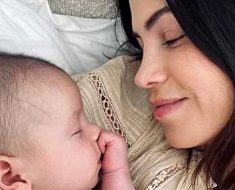Search Pinterest for ideas for “gender reveal parties” and it becomes clear that if you can think it, you can buy it. In fact, you can purchase just about anything to unveil the big “surprise” about the girl or boy baby you think you are having. Some popular picks? Colored powder, confetti cannons, color blasters, candles, party invitations, party games, and party supplies. Anything from bath bombs to piñatas can be purchased in pink or blue for this exact purpose. But recently, Jenna Karvunidis, the apparent “inventor” of gender reveal parties, made an announcement on her public Facebook page — 11 years after cutting into a cake stuffed with pink frosting — that her own daughter is experimenting with gender-nonconforming presentation.
“PLOT TWIST,” Karvunidis wrote on Facebook. “The world’s first gender-reveal party baby is a girl who wears suits!”
Karvunidis, who is a mom and blogger, has been credited with inventing the “gender-reveal” party trend back in 2008 after she wrote an article about her own gender-reveal party for her firstborn on her now-expired blog, High Gloss and Floss. After her blog post, she started to see people mimicking her idea; she then turned her post into a widely-shared article for The Bump — and thus, a trend began.
SheKnows spoke to Karvunidis after her recent Facebook post, to get more of her updated perspective 11 years on. What, we wanted to know, was even the motivation to celebrate a “gender” (sex) reveal in the first place?
“The original inclination to have the ‘gender reveal’ party,” Karvunidis told SheKnows, “was to latch on to the only real ‘fact’ I had about the baby I wanted for so long and couldn’t wait to get to know.”
But the real plot twist, let’s be honest, isn’t that girls can and do wear blue suits. The real twist is that gender reveal parties have never been about gender. Haven’t we all learned the difference between sex and gender already? No? Well, allow us to do some enlightening here, then.
One’s true gender identity cannot be determined until a person confirms it. Gender is about how we see ourselves — how we identify. We assign babies gender based on their biological sex, but it’s really just a guess. That guess is the backbone for parties littered in pink or blue based on an ultrasound that shows a baby’s penis or vagina. The more elaborate the party, the more ignorant the hosts.
The more people seem to celebrate boxing their child into the constraints of binary gender labels that perpetuate specific roles and stereotypes, the less likely they are to understand anything about the reality of biological sex and gender identity. They don’t seem to understand, or care about, the physical and emotional damage that can accompany the popping of a balloon filled with blue or pink confetti.
In most cases one’s body matches their mind and heart; those folks are cisgender. For some of us, our body does not match our gender identity or the physical way we want to present ourselves to the world; we are transgender. The assigned label at birth feels more like a prison than a celebration. It is not just an expectation to behave in a certain way, but it’s an expectation to identify as something we are not.
Karvunidis is learning this too.
“Who cares what gender the baby is? I did at the time because we didn’t live in 2019 and didn’t know what we know now – that assigning focus on gender at birth leaves out so much of their potential and talents that have nothing to do with what’s between their legs.
“It’s just become a bit of a nightmare,” Karvunidis says.
It has been a nightmare for a long time for those of us who are intersex, gender-nonconforming, transgender, or are raising transgender, intersex, or gender nonconforming children.
I was assigned female at birth and was raised according to the stereotypical expectations of what it means to be a girl. I was labeled a tomboy because I was athletic and didn’t like “girly” things and in general didn’t feel at home in my body. I have always known I am not just a female. I am also male. I am nonbinary, and my gender can’t be classified as either male or female.
When do I and other nonbinary folks get to be celebrated? Where are the parties that celebrate the diversity and mystery of gender identities and beauty of the authentic self? When do we stop placing what most think are benign labels on kids to be boys or girls based on their body parts?
Part of my struggles with depression, addiction, and body dysphoria are directly related to trying to fit into what it means to be a woman or man when, as a nonbinary person, I am both and neither. Gender reveal parties are part of a larger social construct that reinforce gender stereotypes and gender roles, feeding into more discrimination and harassment for LGBTQIA+ people and our gender expression.
Studies show LGBTQIA+ folks are at high risk for abuse, depression, joblessness, discrimination, and self-harm. One in five queer people age 13-24 attempted suicide last year, including one in three nonbinary and transgender people.
There is nothing wrong with baby showers, excitement over a new addition to the family, or even telling people if you are planning to assign your baby male or female based on their sex. But all of this stress, frustration, and fear stems directly from what people think they know about gender.
Karvunidis told NPR, “I know it’s been harmful to some individuals… We don’t need to get our joy by giving others pain. I think there’s a new way to have these parties.”
When SheKnows asked Karvunidis what these new parties should look like, she responded, “Maybe they should have size reveal parties. ‘The fetus is 15 inches, making it in the 85% for length. Yay!’ I really have no idea, [but ‘gender reveal’] parties are dated.”
I agree. A celebration of life shouldn’t make someone else’s life miserable or not worth living. Stick to baby showers, and step away from the pink and blue powder cannons.
Source: Read Full Article





